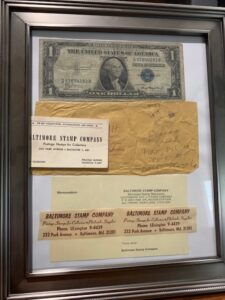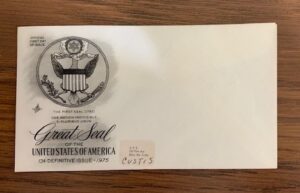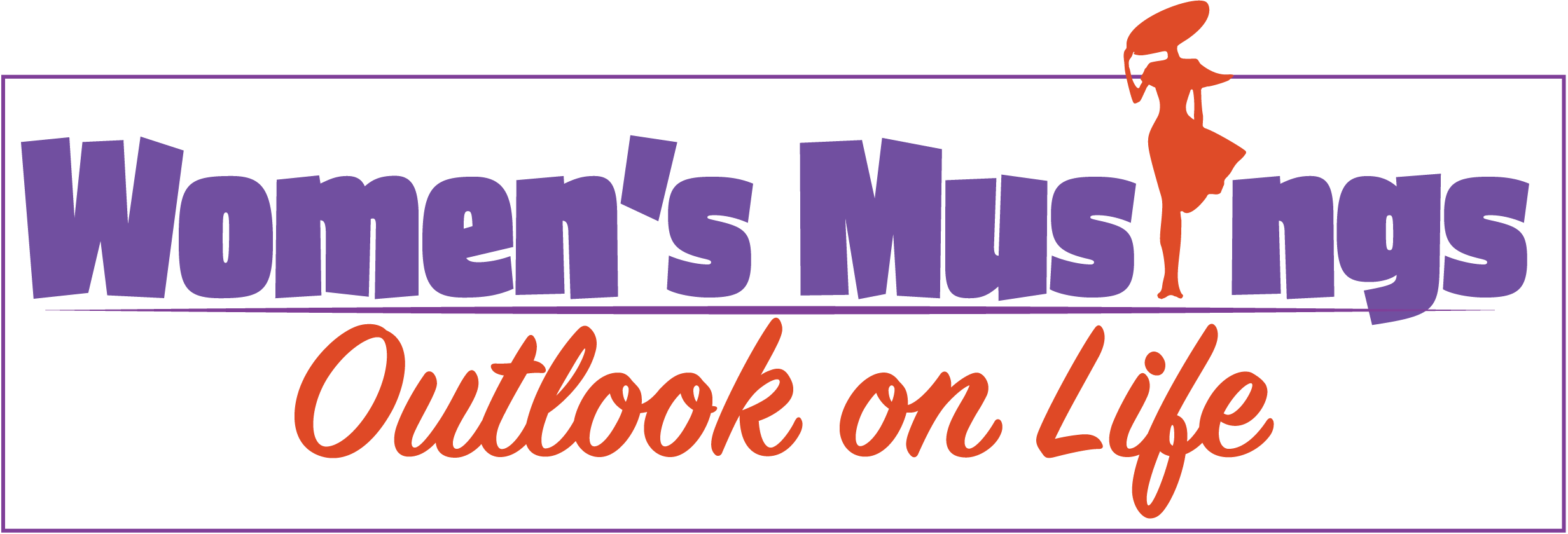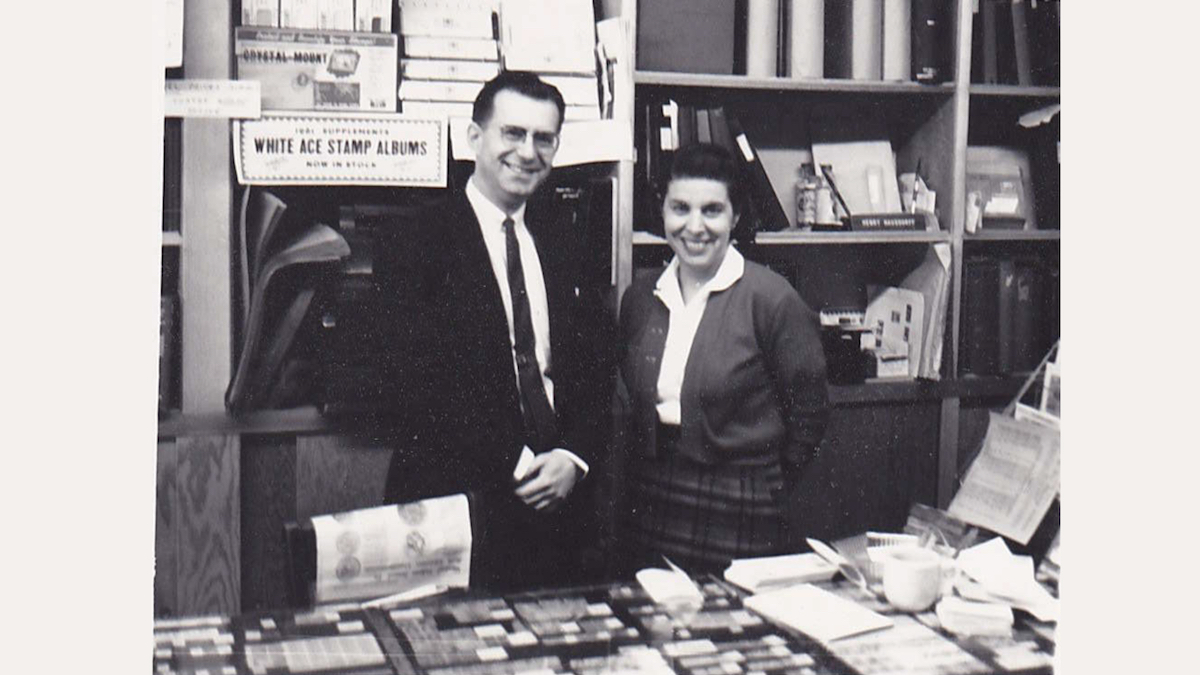The Store
This story is written in memory of my dad, who would have been 101 on July 12, 2022.
Growing up, The Store was a major part of my life. What was The Store? It was Baltimore Stamp Company (stamps for collectors!) located at 232 Park Avenue, LE 9-4439, downtown Baltimore. My parents were the owners, and much of my childhood, upon reflection, revolved around The Store.
Its Beginnings

How did The Store begin? I’m not aware of its origins but can tell you what I remember.
My parents married on VJ Day, September 2, 1945. At that time, Dad was still in the U.S. Army and was stationed in Dayton, Ohio. When he was discharged a few months later, he needed a job. He agreed to an office position in his father-in-law’s business, in Sioux Falls, South Dakota – The Koplow Brothers, a wholesale liquor business.
It soon became apparent that the job was not going to work out. Dad’s parents, meanwhile, had moved to Baltimore during World War II. Being an only child, my grandparents were eager to see their only son return to the East Coast. Grandpa Joe met Mr. Creed, the owner of Baltimore Stamp Company. He was looking to retire and needed a buyer for his business.
Stamps? What Depression-era kid didn’t collect stamps? Of course, Dad knew stamps, or was smart enough to learn. A deal was struck, Mom and Dad moved to Baltimore and the rest, as they say, is history.
Memories of Baltimore Stamp Company Growing Up
After Mr. Creed retired, Dad worked alone in the store until 1958. He needed help, and the best kind of help is the unpaid kind—one’s wife. I was four and one-half-years old. Bais Yaakov School for Girls agreed to enroll me in kindergarten at this tender age so that Mom could work with Dad. While he took the transit bus downtown, I waited at home for the school bus. After being picked up, Mom drove the car downtown to work with Dad.
Mom was supposed to be home before me. One day, she wasn’t home when Sonny, my bus driver, was dropping me off. G-d bless Sonny. Since he didn’t see Mom’s car, he had “the smarts” to drive around the neighborhood until Mom came home. What a nice guy; what a mensch.
My two older sisters, Laura and Margo, attended public school. Their school vacation days did not coincide with mine. It wasn’t worth it to my parents to get a babysitter for one kid. Therefore, my days off from school meant accompanying them to The Store.
Mom and Dad parked the car in the Lexington Market Garage and walked the four-five blocks to Park Avenue. On winter days, The Store was freezing. The radiators had to be lit every morning. That meant sitting in the cold for at least one hour before The Store warmed up. Summer was the opposite: a hot, humid environment. In the 1960s Dad installed an air-conditioning unit. What a difference that made! When the cool air kicked in, Dad and Mom were comfortable (and less cranky when they came home!).
Downtown Baltimore as a Child
Park Avenue in the 1950s and 1960s was zoned for business. Store fronts were typical Baltimore row houses, three-story tall narrow buildings. Some businesses on our block came and went but I remember Rabineaux Jewelers and a check cashing place.
Dad owned the building at 232 Park Ave. Inside, two long tables were placed in an L-shape, with one or two uncomfortable wooden chairs for customers. Dad wanted only the “big spenders” to sit in the chairs and take up his time. Serious stamp collectors could spend hours deciding what to buy and haggling on prices.
The only other seating consisted of two uncomfortable wooden chairs behind the tables. I usually sat at the far-left side of the store, close to a radiator and in direct line with the air conditioning unit.
The Store also had two large, extremely heavy metal safes. They were the old-fashioned kind that stood on the floor, about three feet high, with dials to unlock and levers to open. Every morning Dad would open them and take out “the good stuff” for the display cases. General merchandise, such as stamp albums, stamp packets, tweezers, accessories and less costly items were always on display, not in the safes.
Behind one of the safes was the toilet. Outside the toilet, along the back wall, was the sink to wash our hands. Was the store pristine? Far from it. It always seemed dusty and schmutzy to me, and totally disorganized. Dad knew where everything was, and that was all that mattered.
What did I do all day while my parents worked? Well, there wasn’t a whole lot to do. If it was quiet, i.e., no customers, Mom would walk me to the children’s section at the Enoch Pratt Library. Once I was a bit older, I walked there by myself.
Sometimes, when bored, I’d venture up the creaking stairs of the store to the second floor. Talk about dusty! This was an asthma sufferer’s worst nightmare! But sometimes I found treasures! Once I found a handmade sterling silver tray—which Dad probably got when buying someone’s stamp collection. He let me keep it, and I use it today under my Shabbat candlesticks.
What was on the third floor? I have no idea. It didn’t seem particularly safe to venture up there. Besides, if it was dusty on the second floor, one can only imagine what the third floor was like.
In those days, downtown Baltimore was a shopper’s paradise. Howard and Lexington Streets were the heart of the shopping district. Four department stores anchored the corner: The Hecht Company, Hochschild Kohn, Stewart’s and Hutzlers. Hess shoes, too expensive for kids’ shoes, was a block up. Numerous other businesses surrounded the area, including Brager Gutman’s, a dress shop and I think a five and dime (today’s dollar store).
By the time I was ready for 7th grade, I was enrolled in public school. Therefore, my days off coincided with Margo’s. I no longer had to go with my parents to The Store as I was 11 and Margo was 15.
Miscellaneous Memories of The Store
- Dad’s mantra: All stamp dealers are crooks! Hmm.
- The Store hardly every closed. When we took our summer vacations, my grandfather kept it open. He could sell marked items, like stamp accessories and stamp packets but not the “good stuff.”
- Heroin became a big problem in the city in the 1960s. Dealers used small glassine envelopes to measure out and sell their product. Who else used glassine envelopes? Stamp collectors. Drug dealers came into The Store and bought boxes of them (1,000/box), way more than any stamp collector would ever need. Dad was convinced that the FBI tapped our phones.
- A big seller was stamp packets made up of miscellaneous cancelled stamps. These were great for kids or not-so-serious collectors looking to fill their albums. Mom and Dad would tear off used postage stamps, soak them in water, peel off the stamp from the paper and dry the stamps on our dining room table. Then Mom would make up the packets.
- My dad’s rival and “arch enemy” was another Jewish stamp dealer named Matthew Bennett. We were never allowed to mention his name! Wouldn’t you know it? When Laura went to college, her roommate and best friend Paula got engaged to Mr. Bennett’s son. Oh well.
- In the late 1970s, when Mom and Dad retired, Mr. & Mrs. Bennett moved to our neighborhood and joined our synagogue. They became great friends and went out to eat every Thursday night at the Sinai Hospital kosher cafeteria.
- Dad used to keep The Store open late Thursday nights and on Saturdays, as these were busy shopping times downtown. When we moved in 1965, he decided that he no longer wanted to be open on Shabbat. He expected a significant loss of income. Much to his surprise, his loyal customers accepted this decision and business did not suffer.
- Also in the 1960s, Hutzler’s opened a stamp department in its Towson store. Well, we no longer shopped at Hutzler’s! The first time I bought a dress at Hutzler’s was in 1977, as a newlywed. It took a lot of courage to tell my folks where that cute dress came from.
- Dad took a Sabbatical from the store during the 1964-65 school year. He decided to try teaching mathematics, his first love, and got a job at Milford Mill High School. While he loved teaching, he was unhappy with the administrative paperwork and frustrated with his less than stellar students. His redeeming class was his Geometry class, whom he invited to our house for a bar-b-que on the last day of school. The Store stayed open that year with the help of Mom and my grandfather.
- Mom was in charge of the first day covers. She would handwrite the customer’s addresses on each envelope. This became a chore when the Post Office began issuing multiple new stamps every year. I have about 2,000 blank first day cover envelopes, none of which are worth the paper they are printed on.
- Dad often bartered goods for stamps. When we needed landscaping at our new house in 1965, his landscaper customer planted bushes for stamps. A few months ago, my friend and fellow writer Marlene recommended an electrician. We hired him to install new light fixtures in the basement. When he came upstairs, he said, “I saw the photo of Baltimore Stamp Company on the wall. I used to buy stamps from them. Any relation?” Turns out he was a former customer who did electrical work for my parents and got paid in stamps. Small world, isn’t it?

The End of Baltimore Stamp Company
The riots of 1968 were the beginning of the end for the downtown retail stores. Malls were being built in the suburbs. These were anchored by the local department stores, as well as Sears and Montgomery Wards. Downtown shopping declined. My parents, I believe, saw the writing on the wall and began to plan for retirement.
Sometime in the 1970s, when I was in college, my parents decided to sell The Store. They had a small wholesale stamp business they ran out of our basement and no longer needed the hassle of retail. Eventually, someone from out of town bought the business. About two years later, he went bankrupt. Dad’s customers begged for him to reopen. Mom and Dad did for a couple of years, and then retired for good.
People often ask me how my parents made a living selling stamps. I don’t know but they put food on the table, took us on vacation every summer, sent us to camp and put three kids through college. Dad was more “into” The Store than Mom. He liked the “thrill of the hunt”—finding a collection to buy and making a profit. He liked the game, I suppose, of trying to outsmart the other guy!
And while he did always say that “all stamp dealers are crooks,” he claimed to have never cheated anyone – he bought and sold at fair prices.
After The Store closed, the “good stamps” ended up in their safe deposit box. When my parents wanted to purchase something big, such as a new car, or go on an extended trip to Israel, Dad would sell some merchandise. My sisters and I had no interest in stamps. Thankfully, when Dad passed away (after Mom), no significant inventory remained. Researching the value of the remaining stamps and getting a fair price would have been a lot of work.
Today’s Reality
These days, kids don’t collect stamps or coins. Philatelic societies are made up of geezers, not young people. Perhaps some day stamp collecting will become popular. For me though, my dealing with stamps consists of the “forever” stamps issued by the Postal Service.
Please leave your comments below.
Read more by Eileen Creeger.


I just want to say that I loved the story. Thanks for sharing it. Both my parents lived on Park Avenue when they were out of high school, so I wonder if they ever went into The Store, even just to look around. 🙂 Diane Gensler (friends with Linda, Marlene and Ada)
Do you remember Mr Sherman a few blocks up from the 200 block of Park Ave? He sold magazines and other stuff. He was a “grumpy old man” and venturing into his place of business was scary.